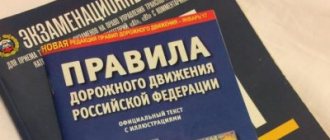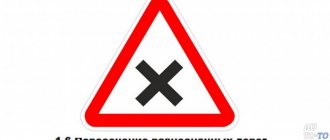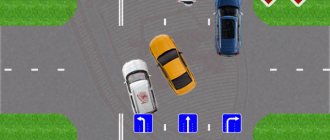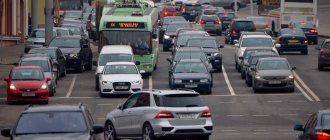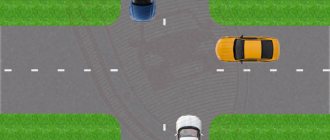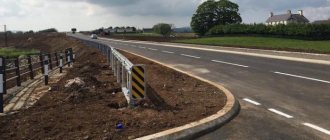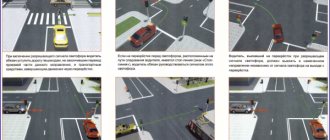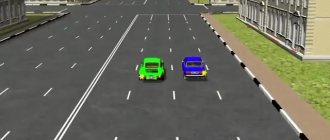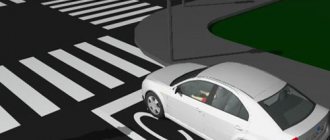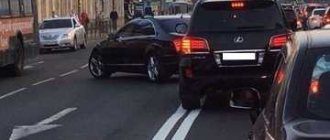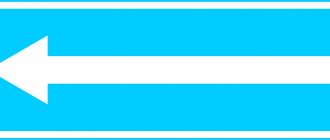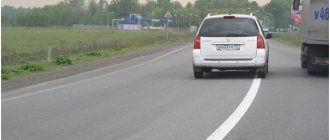- Introduction;
- Traffic regulations on crossing roadways;
- Simple intersection;
- Crossing carriageways on a road with a dividing strip
- Video material
- Intersection of carriageways on a road with divided carriageways (alley, boulevard, etc.)
- Does this theory contradict the current traffic rules or vice versa?
- Conclusion;
Introduction
At first glance, the intersection of roadways does not raise any questions. And everyone who prepared at least a little for the exams to obtain a license easily answered questions about the number of roadways and the number of their intersections at simple and complex intersections.
But suddenly, at one fine moment, having already forgotten about the exam tickets, you make a U-turn on a road with a dividing strip, and barely finishing the maneuver, you are already met by a traffic police inspector with a protocol already filled out under Part 4 of Article 12.15 and a diagram drawn up. All he has to do is enter the last name and information about the driver. And just like that, an ordinary U-turn can result in deprivation of rights for a period of 4 to 6 months.
You will be accused of violating paragraph 8.6 of the Traffic Rules:
8.6. The turn must be carried out in such a way that when leaving the intersection of roadways the vehicle does not end up on the side of oncoming traffic.
Violation of this paragraph of the traffic rules, in accordance with Resolution of the Plenum of the Armed Forces of the Russian Federation of October 24, 2006 N 18, clearly defines the offense under Part 4 of Article 12.15.
They will remind you or you yourself will remember the pictures from the traffic rules exam tickets, they will convince you that you did not turn around, but made two turns, and for complete convincing they will show a photo of the maneuver where your car is on the left side of the intersection on the intersecting road after making the turn .
Such a number of arguments is not in your favor and the surprise factor will undoubtedly discourage you from searching for the truth.
Precisely so that the inspector’s gesture does not come as a surprise to you, and so that you do not seek the truth under pressure from a traffic police officer, in this article we will try together to find a solution and determine the boundaries of the intersection of roadways.
We will not consider turning around a large and small radius, since the main question is to determine the moment of leaving the intersection of roadways , and find the difference between a turn and two turns to the left, and for this we need to determine the boundaries of the intersection of roadways, and then the question of turning around large and small radius will disappear by itself.
The vast majority of comments on the definition of road crossings refer to illustrations in exam papers as the only more or less official source that at least somehow explains this issue. Let us note right away that this definition is not correct!
If we follow the definition of crossing roadways according to the illustrations on tickets, then a small radius turn is always prohibited without exception. But practice, both driving and judicial, shows the opposite.
Back to contents
Traffic regulations on crossing roadways
- Definitions of the Rules of the Road that we will need to solve the problem:
“Road” is a strip of land or a surface of an artificial structure equipped or adapted and used for the movement of vehicles. The road includes one or more carriageways, as well as tram tracks, sidewalks, shoulders and dividing strips, if any.
“Carriageway” is an element of the road intended for the movement of trackless vehicles.
“Traffic lane” is any of the longitudinal stripes of the roadway, marked or not marked with markings and having a width sufficient for the movement of cars in one row.
Please note that the definitions are not in alphabetical order, but in nesting order, i.e. the road includes a carriageway, the carriageway in turn is divided into lanes.
“Intersection” is a place where roads intersect, adjoin or branch at the same level, limited by imaginary lines connecting, respectively, the opposite, most distant from the center of the intersection, beginnings of curvatures of roadways. Exits from adjacent areas are not considered intersections.
Here we note that at the intersection there are rounded roadways , therefore, in addition to straight roadways located on the roads, there are also rounded roadways located directly at the intersection itself. This is the key point in solving the problem.
There is no definition of “Crossing roadways” in the Russian Traffic Regulations.
These are all the conditions that are given to us in the Traffic Rules for solving our problem.
Naturally, they are not enough, so you will have to resort to some logical conclusions. We will try to make these conclusions as close as possible to existing definitions and in no way contradict them.
Back to contents
Simple intersection
Let's start with a simple intersection of two roads that share the same carriageway.
Note! In this image, and in all subsequent ones, there are no road markings. I'll explain why. It’s simple, if the road is not one-way and there is no special traffic regime organized on it, the oncoming lane in accordance with clause 9.1 of the traffic rules always exists, regardless of whether there are markings on the road or not.
Let's look at the illustration of the intersection of roadways that exam cards offer us:
Firstly, with this definition, if there are two carriageways on the road, it is impossible to make a small radius turn under any circumstances, no matter how narrow or wide the dividing strip is. When turning, we will always leave the intersection of roadways without leaving the intersection, and if at the same time we find ourselves in the oncoming lane of the road being crossed, this will already be a turn, and a violation of clause 8.6 of the traffic rules.
Our task is to refute this definition.
The second point is, for unknown reasons, a section of the intersection at the curve of the roadways that was left unattended.
Let's take a fresh look at the intersection again:
An intersection is the intersection of two roads, respectively, the intersection of two carriageways of these roads; also at the intersection there are also carriageways on curves, located only at the intersection, connecting the intersecting carriageways of the roads.
For example, consider the turning maneuver, it consists of three stages
- Driving on road lane 1
- Driving in a lane at an intersection
- Driving on lane 2
By lane definition:
“Traffic lane” is any of the longitudinal stripes of the roadway, marked or not marked with markings and having a width sufficient for the movement of cars in one row.
— there is no contradiction in the location of the traffic lane at the intersection. When turning, our lane is parallel to the curve of the roadway at the intersection.
By definition of a roadway:
“Carriageway” is an element of the road intended for the movement of trackless vehicles.
— there is no doubt that the section of the intersection along the curve is a roadway.
There is an opinion that an intersection is not a road - it is not true! .
The intersection cannot divide the road into parts , and at the intersection the road also continues, with its own carriageway and lanes on this carriageway
The definition of an intersection is necessary to regulate traffic at the intersection of roads, as well as at the intersection of roadways, and at the intersection of traffic lanes. All elements of the road intersect rather than separate. The only time the roadway is interrupted is at a roundabout, but the road is not interrupted.
As a result, the roadway intersection diagram according to the traffic rules definitions looks like this:
The location of vehicles at the intersection is not regulated, but one must understand that the road does not end at the intersection and it is necessary to fulfill all the requirements for the location of vehicles outside the intersection, and maneuvers must be performed in accordance with the requirements for maneuvering and passing through intersections. And remember, maneuvering at an intersection is also carried out on the roadway located at the intersection and along traffic lanes, which are determined in accordance with clause 9.1 of the traffic rules. It’s just that at simple intersections these roadways are less identified and are located mainly in the intersection zone, and at complex intersections the presence of separate roadways is more pronounced; a striking example of this is a roundabout intersection or road junctions on highways at the same level.
If the compilers of exam tickets had not imposed an erroneous interpretation of the Traffic Rules, the number of controversial situations at intersections would have been significantly reduced.
In simple words:
“Intersection of roadways” is the area where roadways intersect, join, or branch at an intersection.
In one of the Commonwealth states this is already spelled out in the traffic rules and there is no need to derive a definition using such extensive theoretical reasoning.
Quote from Estonian traffic rules:
78) roadway – part of the road intended for the movement of vehicles. A bicycle path and a bicycle-pedestrian path are not roadways. A road may include several carriageways separated by median strips. Roadways intersecting at the same level form a roadway intersection zone. The boundaries of the roadway are indicated by appropriate road markings, and if there are no markings, the boundary is the edge of the shoulder, dividing line, landscaping or other strip, the bottom of the gutter or curb stone. If tram tracks of both directions, located at the same level as the roadway, are located on the same side of the roadway, then the boundary of the roadway for trackless vehicles is the tram track rail closest to the roadway;
This is how the Estonian traffic rules solve the issue of crossing roadways and tram tracks simply.
Next, we will look at the intersections of roadways at complex intersections that are already simple for us.
Back to contents
1.3. General provisions. Special sections of the road
February 11, 2015 Administrator Home page » Traffic rules course Views:
How pleasant it would be for the driver to move only on a straight and extremely flat road without changing driving modes: without braking and acceleration, turns and U-turns, signs and markings, traffic lights and traffic controllers. Unfortunately, in reality this is impossible.
And even if you got out on a wide country road and got the opportunity to carry out straight, measured movement, it doesn’t matter! — you will inevitably encounter special sections of roads. What are these special areas? Let's try to figure it out.
CROSSROADS
Whether you like it or not, every driver is forced to move through intersections. There is no escape from this.
“Intersection” is a place where roads intersect, adjoin or branch at the same level, limited by imaginary lines connecting, respectively, the opposite, most distant from the center of the intersection, beginnings of curvatures of roadways.
It would seem like a crossroads. Well, what's easier? However, we have a rather complex definition that forces the reader to form a certain image of this section of the road in his mind. Let's simplify it. “Crossroads” is a place where roads cross, join or branch at the same level...
An intersection is a place where roadways “converge” (intersect, branch, or adjoin each other). It is roadways, not roads. Why is it so important? Yes, because sidewalks and roadsides are elements of the road, but their intersections are not an intersection.
Another important point: the intersection of roadways must be carried out AT THE SAME LEVEL. (Although it would be more correct to say - in one plane).
That is, driving under a bridge, overpass, or overpass will not be considered an intersection, since in reality there is no intersection of roadways at the same level.
Now a few words about the boundaries of the intersection.
“Intersection” is a place ... limited by imaginary lines connecting, respectively, the opposite, most distant from the center of the intersection, beginnings of curvatures of roadways.
Agree, whoever formulated this needs a nail driven into his head. To put it simply, the boundaries of intersections start from the bends of curbs or shoulders. Let's trace this in the figure.
And in this sense, there is a subtle point. In principle, an INTERSECTION and a place where roadways intersect are not the same thing. The intersection is much wider than the intersection. (We will need this in the future.)
Finally, the question of the types of intersections is fundamental. Believe me, there are a huge number of them. Let us not ask ourselves about the reasons for such diversity; they are of purely theoretical significance. Let's just go through this diversity.
Firstly, the classic four-digit – cross-shaped – intersection. Perhaps the most common.
Secondly, a T-junction (which is missing one side passage).
Third, the Y-junction.
Fourth, a roundabout.
Agree that the ways of crossing roadways (or their junctions and branches) can be very diverse. We have indicated only the most typical textures of intersections.
And now - VERY IMPORTANT! The driver must remember that there are difficult intersections.
Please note that a cross-shaped intersection is formed by one intersection of roadways.
However, there are intersections that are formed by two or more intersections of roadways. These are complex intersections. And they arise in the lion's share of cases thanks to the dividing stripes already known to us.
For example, the picture above shows ONE intersection, but it includes two roadway intersections. But in the figure below there is ONE intersection, but formed by three intersections.
But in all the described cases, we are dealing with ONE SINGLE INTERSECTION, formed by the intersections of roadways. You may ask, why do we need this? What if the intersection is formed by one intersection, or two, or even three?
The fact is that some road signs apply to the entire intersection. For example, the sign “Main Road” (2.1).
And there are signs that extend their effect only to the intersection of roadways in front of which they are installed. For example, the sign “Go straight ahead” (4.1.1).
And one last thing. How to calculate how many roadway crossings a particular intersection has? It is necessary to multiply the number of carriageways on one road by the number of carriageways on the other (intersected). The result will be the number of roadway intersections that this intersection contains.
Summarize. An intersection is a special section of the road, which is a place of intersection (junction, branching) of roadways. It is at intersections that the most acute question arises about the priority right to the movement of pedestrians and vehicles. Section 13 of the Traffic Rules and our comments on it are devoted to this problem.
The next concept associated with special areas is ADJACENT TERRITORY.
“Adjacent territory” is the territory directly adjacent to the road and not intended for through traffic of vehicles (yards, residential areas, parking lots, gas stations, enterprises, etc.). Movement in the adjacent territory is carried out in accordance with these Rules.
Let us immediately make a reservation that the adjacent territory IS NOT A ROAD (by definition), but the Traffic Rules apply on it.
And here the driver must sacredly remember the main principle associated with such a section: EXITING ANY ADJACENT TERRITORY (and, therefore, entering it) IS NOT CONSIDERED A INTERSECTION.
Let's take a close look at the drawing of a gas station and answer the question: “Well, what kind of intersection is this?”
Why is this so important? Yes, because some very important signs (for example, 3.24 “Maximum speed limit”) are valid from the place of installation to the nearest intersection along the route.
And if the driver incorrectly evaluates the entrance to the yard, mistaking it for an intersection, and considers that the sign has ceased to be valid, then he will grossly violate the Rules. The sign is not canceled by entry into the yard or other adjacent territory.
And one last point. The surrounding area is not intended for through traffic. In other words, it cannot be used to shorten the path, avoid traffic jams, etc. When entering the adjacent territory, the driver must have the goal of his movement to perform some actions here (parking, refueling the vehicle, etc.).
Next up is another concept – SETTLEMENT.
“Settled area” is a built-up area, the entrances to and exits from which are marked with signs 5.23.1 - 5.26.
In other words, the presence of these signs is a criterion for the populated area itself. But here another question arises: “Why are there three pairs of signs indicating a settlement? Isn’t one enough?”
The question is spot on! Exactly – it’s not enough! We talked about this in more detail in the comments to signs 5.23.1 – 5.26. Here we just note that road signs, made in black and white colors, are used to designate a populated area in which the Rules establishing the principles of traffic in a populated area apply.
The driver, seeing these signs, must understand that he is entering a “real” populated area (or leaving it).
But the blue and white signs inform the driver of something else: somewhere next to the road there is a “real” settlement. But this road does not pass through it. Therefore, according to the Rules, the driver continues to move, as if being in a situation outside a populated area (with all the ensuing consequences).
Agree, there is some confusion or understatement in the Rules regarding the concept of “settled area”. Let's hope that the situation will someday change for the better.
The next special section of the road is the RAILWAY CROSSING.
“Railway crossing” is the intersection of a road and railway tracks at the same level.
An important criterion for crossing is the intersection of the road with the railway tracks at exactly the same level (in the same plane). Driving under a railway bridge is not a crossing.
Is it worth convincing drivers that a railroad crossing is a very dangerous section of the road? It’s not for nothing that the entire 15th section of the traffic rules is dedicated to him. The practice of road accidents is replete with examples of serious fatal accidents that occurred at railway crossings.
We will provide more detailed comments when analyzing the relevant section of the Rules. Here we will only state the very fact of the presence of such a concept in the traffic rules,
Another important section of the road is the PEDESTRIAN CROSSING.
“Pedestrian crossing” is a section of the roadway marked with signs 5.19.1, 5.19.2 and (or) markings 1.14.1 and 1.14.2 ... and allocated for the movement of pedestrians across the road. In the absence of markings, the width of the pedestrian crossing is determined by the distance between signs 5.19.1 and 5.19.2.
The passage of a pedestrian crossing is regulated by the special 14th section of the traffic rules. And we will consider the principles of vehicle movement along this dangerous section of the road when analyzing this section. Here we will only outline the main priorities.
As can be seen from the figure above, the pedestrian crossing is marked with “Pedestrian Crossing” road signs (5.19.1 and 5.19.2). In this case, the width of the transition is the distance between the characters.
However, a pedestrian crossing can also be marked using zebra crossings (1.14.1 and 1.14.2). Here the width of the transition is the width of the zebra.
Or a combination of markings and signs.
In the latter case, the width of the pedestrian crossing is the width of the markings.
What should a driver remember when approaching a pedestrian crossing? First of all, on this section of the roadway pedestrians have priority over vehicles.
Let's stop, as they say, on this shore. Although, in fairness, it should be recognized that at an unregulated pedestrian crossing, pedestrians have the right to enter it only after they are convinced that it is safe to cross the roadway. We’ll talk about this in more detail when analyzing section 4 of the traffic rules “Responsibilities of pedestrians”.
Finally, the last section of the road that we consider special is the HIGHWAY.
“Motorway” is a road marked with sign 5.1 ... and having carriageways for each direction of travel, separated from each other by a dividing strip (and in its absence, by a road fence), without intersections at the same level with other roads, railway or tram tracks, pedestrian or bike paths.
Traffic on the highway is regulated by the special 16th section of the Rules. By the way, have you noticed that almost all the special sections of the road that we have already commented on above are designated and regulated by special sections of the traffic rules? This once again confirms their importance. And the highway is no exception.
The first criterion for a highway (and this can be seen in the figure) is the presence of a dividing strip (or road fence). This is done in order to maximize road safety, when the possibility of a vehicle entering oncoming traffic is almost completely eliminated:
The second criterion for this road is an extremely small number of intersections, as well as the complete absence of railway crossings, tram tracks, bicycle and pedestrian paths, surface pedestrian crossings, and tram tracks.
Even the symbolism of the “Highway” sign (5.1) is a demonstrator of the latter requirement. The sign shows an overpass and the highway passage underneath.
Traffic regulations introduce a whole range of restrictions regulating traffic on the highway. Let us remind you once again that Section 16 of the Rules is entirely devoted to this. That is why we will undertake a detailed analysis of traffic conditions along this dangerous section of the road there. The purpose of this commentary is to position the highway as a special section of the road.
Let's summarize. The traffic rules provide for the presence of special (usually dangerous) areas, the movement of which requires the driver to be attentive, careful, as well as knowledge and strict adherence to the Rules.
If this information was useful to you, please write about it in the comments. If you have any questions, write, we will definitely try to help you.
Traffic regulations online from the autoass team!
The content of the article:
- what is a crossroads
- this is a crossroads
- traffic intersection
- crossroads in your own words concept
Tags: highway, railway crossing, populated area, intersection, pedestrian crossing, surrounding area
Crossing carriageways on a road with a dividing strip
One intersection of roadways, a small radius turn is allowed.
The reversal in this case will be carried out in three stages:
- Driving on road lane 1
- Driving in a lane at an intersection
- Driving in the opposite direction along lane 1.
Please note that there is no traffic on road 2, in this case this road intersects, in the same way if there was no median strip.
Departure from the intersection of roadways is carried out simultaneously with departure from the intersection.
Back to contents
Concepts of intersection and roadway
Let us quote paragraph 1.2 of the traffic rules:
Practical determination of the center point of an intersection can be difficult since the exact search methods are not specified.
To find the intersection of roadways, you should take a pair adjacent to the intersection and determine the area of its overlap.
In the figure, the intersection of roadways is highlighted with a yellow line. Let's look at some common options.
Intersection of carriageways on a road with divided carriageways (alley, boulevard, etc.)
As we see in this case, a clearly defined roadway appeared at the intersection. And despite the fact that it is located at the intersection of roads and belongs to the road being crossed, it is not part of the intersection of roadways , because the direction of the roadway in this section is parallel and coincides with the direction of the roadway of the road being intersected and, accordingly, if the intersection is located parallel, there cannot be
Movement along this section of the roadway is carried out in a straight line and a turn is already being made onto the road being intersected. Departure from the intersection of roadways takes place at the intersection and the vehicle, when moving along the roadway at the intersection, is already on the road being crossed.
The reversal in this case will be carried out in 5 stages:
- Driving on road lane 1
- Turn left in the lane at an intersection
- Driving on lane 2
- Turn left in the lane at an intersection
- Driving in the opposite direction along lane 1.
Thus, in this case, a turn is made by making two turns to the left.
In this situation, a short-radius turn is prohibited.
Back to contents
General travel rules
To make it easy for you to understand what to follow when driving through absolutely any intersection, I present the following diagram:
- It is prohibited to drive to an intersection (intersection of roadways) if a traffic jam has formed behind it, as a result of which the driver will find himself at the intersection and impede the movement of vehicles moving in other directions. It turns out that in this case it will be possible to enter the intersection if you then have to leave it, for example: turning left/right or making a U-turn.
To automatically record this violation, a term such as waffle marking was introduced. - If a driver turns left or right, he must give way to both pedestrians and cyclists who are crossing the roadway he is turning onto. Moreover, it does not matter at all whether there is a “pedestrian crossing” sign or corresponding markings (zebra crossing).
Does this theory contradict the current traffic rules or vice versa?
What can change in the current traffic rules if we apply this method of interpreting the intersection of roadways?
6.13. When there is a prohibitory signal from a traffic light (except a reversing one) or from a traffic controller, drivers must stop in front of the stop line (sign 6.16), and in its absence:
- at an intersection - in front of the roadway being crossed (taking into account clause 13.7 of the Rules), without interfering with pedestrians;
- …
The roadway being crossed also runs along the road being crossed, with the only difference being that now it is not the boundary of the intersection of roadways.
There is no contradiction
8.6. The turn must be carried out in such a way that when leaving the intersection of roadways the vehicle does not end up on the side of oncoming traffic.
Now a double interpretation of this clause of the traffic rules is excluded, which is why this article was written.
9.8. When turning onto a road with reverse traffic, the driver must drive the vehicle in such a way that when leaving the intersection of roadways, the vehicle takes the far right lane. Changing lanes is permitted only after the driver is convinced that traffic in this direction is also permitted in other lanes.
It is possible to occupy a lane when turning onto the road only after the end of the maneuver, when the vehicle takes the appropriate position parallel to the direction of the road. And when turning right, in the case of a large radius of curvature, according to the old concept, it was possible to bypass the intersection of roadways altogether and make a turn without entering this intersection.
Now this contradiction has been eliminated .
13.2. It is prohibited to drive to an intersection or intersection of roadways if a traffic jam has formed that will force the driver to stop, creating an obstacle to the movement of vehicles in the transverse direction.
It seems that the zone into which it is prohibited to travel has changed, but it is only possible to interfere with vehicles in the transverse direction by occupying the carriageway of the road being crossed.
There is no contradiction.
But how to go only to the intersection, without going to the intersection of roadways and create an obstacle to the movement of vehicles in the transverse direction, regardless of the interpretation of the intersection of roadways, the question remains open.
The effect of signs 3.18.1, 3.18.2 extends to the intersection of roadways in front of which the sign is installed.
The effect of signs 4.1.1-4.1.6 extends to the intersection of roadways in front of which the sign is installed.
There is no fundamental difference in the size and shape of the roadway intersection zone. Whether it is an even rectangle or a figure with corners rounded inward.
There is no contradiction
Back to contents
Driving through controlled intersections
At controlled intersections, the order of movement is determined by signals from the traffic light or traffic controller. If the traffic controller’s signals contradict the traffic light signals and the instructions of the road signs, then you must be guided by the traffic controller’s requirements.
If traffic light signals contradict the requirements of road signs 2.1, 2.4 or 2.5, then you must be guided by the traffic light.
The permitting signal from a traffic light or a traffic controller allows you to enter a controlled intersection. Permissive traffic light signals are:
| Green light | Green light with green additional arrow | Red or yellow light with green additional arrow |
| Allows entry to the intersection. | Allows entry to the intersection and movement in all directions. | Allows entry to the intersection only for traffic in the direction indicated by the arrow. |
It is important to know! When driving on a prohibitory (red or yellow) signal with a green additional arrow, the driver must give way to any vehicles moving from other directions.
When there is a prohibiting signal from a traffic light or a traffic controller, the driver must stop in front of the stop line indicated by markings or sign 6.16, and in their absence, in front of the roadway being crossed, without interfering with pedestrians.
Conclusion
We should not forget that theory and practice very often diverge, especially when practice has long been in conflict with theory. And it should be remembered that most traffic police officers are not competent enough in knowledge of the theoretical part and absolutely always tend to interpret any situation not in favor of drivers. Therefore, even if you are confident that you are right, it is always better to make a U-turn in a large radius; it will take a little longer, but it will guarantee to avoid the attention of traffic police officers.
Dear you without obstacles!
Back to contents
